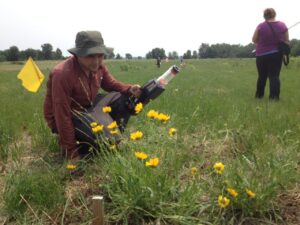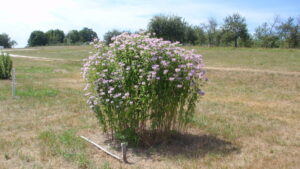2015 Annual Report for LNC14-361
Insectary Plants to Enhance Beneficial Insects: Expanding the Palette to Increase Options for Sustainable Crop Production in the NC Region
Summary
The goal of this project is to conduct research and education to increase the availability of insectary plants to enhance beneficial insects in the North-central Region. In 2015, we conducted weekly sampling of natural enemy and pollinator abundance on 54 species of plants in three common-garden research sites located at: 1) Southwestern Michigan Research and Extension Center (SWMREC), the Clarksville Research Center (CRC), and Northwestern Michigan Horticultural Research Center (NMWHRC). Our preliminary results from SWREC and CRC indicate that 16 species were highly attractive to both natural enemies and pollinators. Additional species are likely to join this highly attractive list as they mature in 2016. Our preliminary results were shared with a variety of scientific and lay audiences via field days, research presentations, and poster presentations. We also began work with our web design team to develop more effective means of sharing this information with stakeholders via our nativeplants@msu.ed website.
Objectives/Performance Targets
2015 objectives
- Sample plants for natural enemy and pollinator abundance and plant traits at all three locations.
- Host field days to inform stakeholders about the project and preliminary results.
- Initiate redesign of website to incorporate 2015-16 information
Accomplishments/Milestones
In 2015, we conducted research at three common-garden research plots in Michigan where 60 species of potential insectary plants have been established in replicated plots in the previous year. Plants were sampled weekly while in bloom to assess plant traits including; height, percent cover, and floral area. Pollinators and natural enemies were sampled to determine the relative attractiveness of plant species. A total of 54 species bloomed in 2015 and sampling occurred from May through October. While species differed in their attractiveness, overall there was a significate positive correlation between attractiveness natural enemies and pollinators. Our preliminary data suggest that during the early-season; common cinquefoil, lance-leaved coreopsis, birdsfoot trefoil, yarrow, and sundrops are highly attractive to beneficial insects. During the mid-season, wild bergamot, early goldenrod, gray goldenrod, mountain mint, hairy mountain mint, and spotted bee balm were the most attractive species. In late-season, tall coreopsis, stiff goldenrod, pale leaved sunflower, sky blue aster, and showy goldenrod were the most attractive plants. Some plants that did not bloom or bloomed at reduced rates in 2015 due to their young age are likely to join this highly attractive list in the future.
 Logan Rowe use a bee vacuum to sample pollinators attracted to lance-leafed coreopsis.
Logan Rowe use a bee vacuum to sample pollinators attracted to lance-leafed coreopsis.  Wild bergamot in full bloom at NWMHRC July 29, 2016. Note the senesced grass indicating the dry soil conditions and wild bergamot’s relative drought resistance.
Wild bergamot in full bloom at NWMHRC July 29, 2016. Note the senesced grass indicating the dry soil conditions and wild bergamot’s relative drought resistance.
Impacts and Contributions/Outcomes
At this stage of the project our goal was to raise awareness among a wide group of stakeholders that this research was taking place and that results would be forthcoming over the next few years. We achieved this by introducing the project at two field days and in numerous presentations for varied stakeholders (see below for full list).
Field Days
Screening Native Plants for Attractiveness to Beneficial Insects. DA Landis, L Rowe, D. Gibson. J Perrone. Clarksville Research Center Field Day. June 16, 2015
Screening Native Plants for Attractiveness to Beneficial Insects. DA Landis, L Rowe, D. Gibson. J Perrone, L Brudvig. Northwest Michigan Horticultural Research Station Field Day. Sept. 17, 2015
Presentations (presenter name in bold)
Insectary Plants to Enhance Beneficial Insects: Expanding the Palette to Increase Options for Sustainable Crop Production in the NC Region. DA Landis, J Perrone, R Isaacs, J Landis, L Brudvig, A Groves. The Stewardship Network Conference: the Science, Practice and Art of Restoring Native Ecosystems. East Lansing, MI. January 23-24, 2015. (poster)
Enhancing Beneficial Insects with Native Plants. DA Landis. The MSU Organic Farmer Training Program. July 15, 2015
Integrated Crop Pollination Project: diversifying pollination sources for sustainable fruit and vegetable production. R Isaacs. Cardno JF New Open Day, Walkerton, Indiana. July 17, 2015.
Evaluation of Michigan native plants and ‘bee keeper picks’ for pollinators in Michigan. Logan Rowe, Rufus Isaacs, Daniel Gibson, Julia Perrone and Doug Landis. Poster presentation at the Protecting Pollinators in Ornamental Landscapes Conference. Hendersonville, NC. October 12-14, 2015. (poster)
Best management practices to support bees on farms. R Isaacs. Blueberry Pollination Workshop, Trevor Nichols Research Center. Fennville, MI. November 4, 2015.
Evaluation of Michigan native plants and ‘bee keeper picks’ for pollinators in Michigan. Logan Rowe, Rufus Isaacs, Daniel Gibson, Julia Perrone and Doug Landis. Poster presentation Entomological Society of America National Meeting. Minneapolis, MI November 15-18, 2015. (poster)
Enhancing arthropod-mediated ecosystem services using plants native to dry sandy soils in Michigan. DR Gibson and DA Landis. Entomological Society of America National Meeting. Minneapolis, MN. November 16, 2015.
Evaluation of Michigan native plants and ‘bee keeper picks’ for pollinators in Michigan. Logan Rowe, Rufus Isaacs, Daniel Gibson, Julia Perrone and Doug Landis. Great Lakes Fruit, Vegetable, and Farm Market Expo. Grand Rapids, MI. December 9, 2015. (poster)
Collaborators:
Professor and Extension Specialist
Michigan State University Department of Entomology
Center for Integrated Plant Systems Lab
578 Wilson Rd., Room 202
East Lansing, MI 48824
Office Phone: 5173556619
Website: http://www.isaacslab.ent.msu.edu/Home.html
Senior Academic Specialist
Michigan State University IPM
Food Safety and Toxicology
1129 Farm Lane, Room B18
East Lansing, MI 48824
Office Phone: 5173534951